Pro-wrestling is essentially a classical “morality play.” Not necessarily the most sophisticated or “politically correct” production, but there are lessons to be learned

The sitting President of the United States posted this fabricated video of him “physically attacking” the cable news network CNN.
By Seth Davin Norrholm, Ph.D and David M. Reiss, M.D.
In this article, the authors discuss this President’s battle with the mainstream media as recently illustrated by a Twitter post in which he appeared to violently attack a man meant to represent a major cable news outlet.
Note: Co-author David M. Reiss, M.D. (dmr@DMRDynamics.com) has an ongoing relationship with the professional wrestling community, speaking and writing regarding both “wellness/mental health” issues and understanding the psychological impact of ring persona on fans. No pro-wrestler or wrestling organization had any input to the content of this article.
The sitting President has waged a longstanding war with the mainstream media as evidenced by his labeling of cable news outlets that portray him unfavorably as “fake news” while actively championing, echoing, and circulating the views of favorable outlets through his public appearances and via his Twitter feed. This contentious relationship with the media, which on its own is not unheard of for a sitting President, reached an unprecedented level late last week.

This Tweet, posted to the @realDonaldTrump Twitter account, illustrates the President’s ire toward CNN, the cable news network that was depicted as the “victim” in the aforementioned fabricated video.
The President posted a contrived video obtained from Reddit that depicted the Commander-in-Chief as violently attacking a man ringside at a World Wrestling Entertainment (WWE) event – the man’s face was concealed by a pixelated image of the CNN logo. The attack on the media member was, of course, fabricated, however, the President’s appearance at the professional wrestling event did occur in 2007 (WrestleMania 23) and the man whose identity was hidden was WWE CEO Vince McMahon. It should be noted that Vince McMahon is a longtime associate of Donald Trump and McMahon’s wife, Linda, is a current Trump Cabinet member as the head of the Small Business Administration.
As we discuss below, whether intentional or not, the use of a professional wrestling-based video tapped into the interests Trump’s vehemently loyal base as well as the impressionist thinking (guided by emotions, feelings, or thoughts rather than specific knowledge or facts) through which many of his followers operate. At the same time, a real understanding of professional wresting might modulate Trump’s sadistic behaviors.
But why is the wrestling imagery so effective?
The Appeal of Professional Wrestling and its Link to Raw Human Emotions
The appeal of Trump’s fake CNN body slam video, and professional wrestling in general, lies in a term used for generations among professional wrestling, “kayfabe.” In short, this term refers to the unspoken agreement between performers (in this case wrestlers) and their audience that, although each party knows the performance is scripted, this is not discussed and the emotions that are evoked are “real.” A recent New York Times article used the concept of “kayfabe” to explain the ongoing support of embattled right-wing radio personality Alex Jones despite his admission, under oath, that his rants were a performance.
To use an analogy, when watching a James Bond movie, the viewer hopes to “lose” themselves in the story, as if it depicted real life. But if meeting Sean Connery or Daniel Craig in person, one would not expect that either has a “license to kill.” Kayfabe is the implicit agreement between the actors and the fans to “stay in role” at all times, even “off screen”/out of the ring.
The viewing of professional wrestling matches and the President’s body slam allow the follower to tap into primal, raw emotions (e.g., anger, rage, frustration) in a contrived environment that facilitates the appropriate release of these feelings. It certainly may be argued that professional wrestling is not necessarily the healthiest or most sophisticated outlet for angry or sadistic impulses, but to understand professional wrestling is to realize that it is intended to be a safe outlet – for both the wrestlers and the fans.
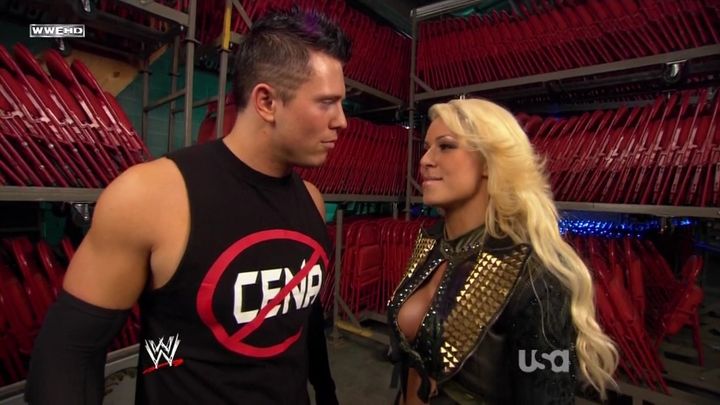
Professional wrestling allows viewers to channel and release raw emotions such as anger, rage, and frustration in a ”safe,” appropriate environment. Although the wrestlers themselves engage in fierce “inside the ring” rivalries (such as the pictured example between The Miz, left, and John Cena, not pictured), it is critically important among professional wrestlers to maintain mutual respect and concern for each other's well-being.
In addition, within the community of professional wrestling, talent, of course, is prized and admired. But of even more importance among professional wrestlers, is mutual respect and concern for each other's well-being.
A look at some of the professional wrestlers in the past few decades demonstrates how anger toward a particular type of person, nationality, or persona can be expressed through “kayfabe-”based performances. Whether considered politically correct or not (often not), and whether or not based upon the heritage of the wrestler, over the years, popular characters have represented various ethnic groups and ideologies such as:
· Nikolai Volkoff (a Russian”heel” villian, portrayed by a Croat)
· Tatanka (Native Americans) – Christopher Chavis, Native American, born in North Carolina
· The Iron Sheik (Middle Easterners) - Iranian- born Hossein Khosrow Ali Vaziri, who was, in “real life”, the assistant coach to the USA team for the 1972 Olympic Games in Munich
· Mil Máscaras (Mexicans - Aaron Rodríguez Arellano, born in Mexico)
· The Undertaker (Death)
· Awesome Kong (Africans – Los Angeles born Kia Michelle Stevens)
· Jinda Mahal (Indians - current WWE champion; Yuvraj Singh Dhesi, of Indian heritage, born in Calgary, Canada)
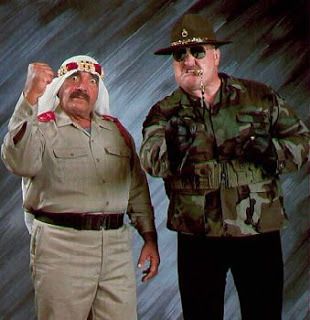
Whether politically correct or not, professional wrestling allows the viewer to “play out” emotionally charged international conflicts such as those that occurred in the 1980s and early 1990s between the United States (represented by Sgt. Slaughter, right) and Iran or Iraq (represented by The Iron Sheik, left).
In addition to these characters (or caricatures), there have also been wrestling personas that reflect positive ideals and aspirations such as:
· The Million Dollar Man (financial success and wealth)
· Sgt. Slaughter (American military might – he was actually pitted against The Iron Sheik)
· Mr. Perfect (athletic prowess)
· John Cena (“Hustle, Loyalty, and Respect”)
In other words, one could play out emotionally charged conflicts ranging from the 1980s Cold War with the Russians, conflicts in the Middle East, or more existential battles such as the struggle between life and death (mortality) and in general, between good and evil.
In a similar fashion, for those who grew up in the 1980’s, the same raw emotions were played out in watching Rocky IV in which an American hero, through boxing, “battled” our archenemy in the Cold War, Russia, as epitomized by the hulking, seemingly invincible Ivan Drago (portrayed by Swedish actor Dolph Lundgren).
In summary, the wrestling “storylines” often have added emotional impact when they reflect an awareness of the complex and serious issues that are being played out symbolically, or perhaps even more so, by having the action unconsciously “hook” realistic concerns, fears, and conflicts. Even if the storyline is at some level a caricature, or “over the top,” if it strikes the right chords, it can be emotionally powerful and engrossing.
The Appeal of the Performers
The persona/character of the Professional Wrestler, and the relationship between the Wrestler and the fan are not just side interests, not just passing curiosities, not just fodder for tabloids – but the primary focus around which the athleticism and competition revolves. Without any doubt, skill and talent are essential, both to the entertainment value of any match, and to the safety of all concerned. Yet it is the fans’ interactions with the Wrestlers, and the Wrestlers’ direct communication with the fans – before, during and after matches – that “makes or breaks” the Wrestler “getting over” as a fan favorite and the success of the wrestling promotion. The dynamics of the interactions between Wrestlers and their fans goes far beyond simply “rooting for the good guy and hating the bad guy” (or visa versa), or “imagining you’re beating up your boss”. Every time a Wrestler steps into a ring, every time a “promo” is cut, intense emotions and psychological complexes are being activated in the fan; from our point of view, many of which are unconscious.
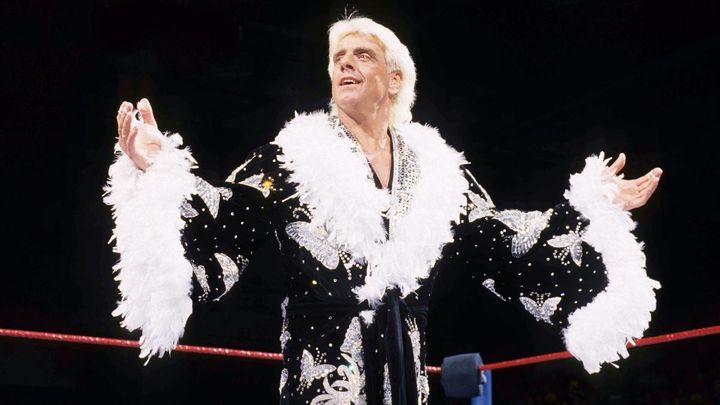
The appeal of professional wrestling to many fans is the direct engagement and communication with the fans, as shown here by Ric Flair, before, during, and after the match.
As introduced in the previous section, highly charged emotional issues ranging from morality to self-esteem to personal identity to fear of danger (and even fear of mortality) all are brought into play. To some in the industry, an understanding of how to reach fans at this level is largely intuitive; to some it is learned from the Masters of the industry; to some, frankly, it is a struggle.
When applying the mentality of the professional wrestling viewer to today’s sociopolitical scene, one can argue (as does NY Times writer Nick Rogers) that the Trump supporters know what they are seeing is largely a performance and that Trump may not actually ban all Muslims, build a rather fantastical border Wall, or body slam a left-leaning reporter – but it sure feels good to act it out through the spectacle of Trump.

A representative Tweet by a supporter of the current President in response to the posting of the “body slam” of CNN. While the supporter may be aware that what they see in Donald Trump is largely a performance, they are still able to feel a strong emotional response to the content of the video and, by proxy, stronger affiliation to the man.
The Psychology of the Wrestling Fan (or Trump Supporter?)
In order to better understand the emotional appeal of “playing out” emotions through “kayfabe” activities such as professional wrestling fanhood, there are several questions to ask:
What does the wrestling fan want from the experience (but doesn’t necessarily doesn’t realize he/she wants)?
We will discuss the psychologically deeper motivations underlying followers of professional wrestling in a later section. First, let’s explore the more obvious (or conscious) motivations including:
I- Motivations Behind Professional Wrestling “Fanhood”
· Outlet for frustration and anger
Everyone has frustrations, grievances, grudges, and angry feelings that they cannot safely or appropriately express. Imagining attacking a specific person or that person being “beat down” (e.g., boss, co-worker, friend, family member) can safely release tension and relieve feelings of helplessness and weakness.
· Release of aggression
Everyone has a capacity for pure aggression that needs to be kept in check in day-to-day life. Having a time and place for the fantasized (vicarious) expression of aggression can also provide a sense of emotional release and can counter feelings of helplessness and weakness.
· Quest for justice
This type of motivation includes two subparts that are related to a concept in psychology known as the “Just World Hypothesis” – which, simply put conceives of an existence in which the good are rewarded and the evil are punished. The first underlying motivation is the Reward of the Righteous, or the righting of injustice involving both personal issues and general societal events. In other words, cheering on the victory of the “righteous” restores a sense of “balance” to an unbalanced world. The second, or antithetical, underlying motivation is Punishment and Revenge Against the Unjust. Regardless of personal philosophy, faith or belief, the impulse to seek revenge for slights and injuries, and punishment for the “wicked”, is an unavoidable human impulse. Cheering on righteous punishment, without needing to take any personal responsibility for the act, releases tension and also restores a sense of “balance” to the world.
· Blood-lust, sadism, masochism
While every person is inherently capable of, and unavoidably experiences, aggressive impulses – for various more complex reasons, there are those who overtly enjoy inflicting and/or experiencing pain, or watching pain being inflicted.
· Beyond “good” and “evil”
Motivation of this type involves both ignoring the “politically correct” and briefly living outside of common laws and morality. Society imposes restrictions upon behaviors that must be followed if one is not to be considered “bad,” “evil,” or “sociopathic”. Restrictions range from the logical, ethical, humane, and moral limits upon behavior, to politically-enforced codes of behavior which may be of questionable, dubious, or malicious “moral” authority. The ability to participate in a virtual world where there they need not be concerned about “political correctness” or the complexities of morality can be temporarily suspended provides a sense of release and relief.
Inherently deeper explanations for one’s pursuit of “kayfabe” activities such as pro wrestling include largely unconscious emotional connections and motivations including, but not limited to:
· Desire to be indestructible
Part of child/human development involves the hope and expectation that we will be perfectly, totally, and consistently protected; that we will be made invulnerable and indestructible. Simply put, that we will “live happily ever after.” No matter how much life proves that to be a childhood fairy tale, we retain a secret wish to return to that sense of total security. By watching larger-than-life figures who appear to be invulnerable to pain and injury, unconsciously, those feelings of safety are revived.
· Desire to be all-powerful
As a child ages, the fantasy of being invulnerable becomes more complex and develops into a wish to be all-powerful, a quest for omnipotence over one’s environment (physical environment and interpersonal environment). The fantasy is established that if I can connect with or join forces with another very special person, group, or institution, together we will become all-powerful and indestructible. (We discussed the phenomena of “Shared Omnipotence” in a previous article.) A large percentage of the population never matures beyond this view of life. Especially for those who have experienced trauma during childhood, the wish for invulnerability can become extremely entrenched. “Normally” every child goes through some emotionally difficult/traumatic events, and therefore, this dynamic is basically universal. However, the more traumatic that a childhood is, the more difficult it is for a person to mature past the view of life hat requires them to hold on to a sense of “secret” invulnerability. This occurs particularly in situations where the child suffers or witnesses abuse (whether within the family or outside the family, such as in the community). Wrestling storylines can unconsciously trigger this fantasy for those who continue to have a hidden wish for omnipotence, providing a significant sense of emotional release and gratification that may not be consciously appreciated, but still may have almost addictive qualities. This is perhaps the most powerful connection to the fan base, whereby one can overcome experiences of everyday frustration, helplessness, defeat, or even depression and despair.
· Desire for an “extended” family
The secret sense of personal loneliness in our society cannot be underestimated. Beyond the issues of invulnerability and omnipotence, participation in the “wrestling community” establishes a simple but powerful sense of being a part of a “virtual family” which can provide at least a transient sense of relief and comfort through an emotional connection with specific “larger than life” characters within the wrestling “family”. The unique interaction between the wrestler and the fans, which is different from the interaction between performers and audience that develops in essentially every other form of sports and entertainment, powerfully allows the development of a sense of personal connection and “family.”
II – Fantasy and suspension of reality
The fan base wants to suspend their sense of reality and, consciously or unconsciously, enjoy the feelings of relief and release as discussed. A useful way to understand the “degrees” of suspension of reality is to view the spectrum of “fantasy” as ranging from the realistic, to the unusual-but-not-improbable, to the improbable-but-not-implausible, to the implausible/irrational. The most powerful emotional connection to the fans is formed by maintaining a position roughly in the middle of that spectrum – improbable but not implausible. If events are realistically “improbable”, but not completely implausible or irrational, an almost hypnotic state can be elicited. In that state, the fans can feel directly emotionally involved, leaving behind “realistic” everyday concerns and boundaries, without feeling that they are being “manipulated” or “fooled”.
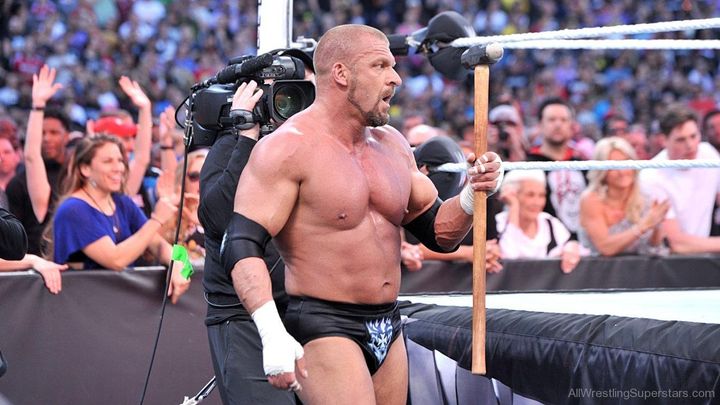
The use of props such as steel cages, caskets, ladders, folding chairs, and yes, Triple H’s sledgehammer (pictured above), allow the viewer to suspend reality and become further engrossed, at least for the duration of the match, in the fantastical world of professional wrestling.
III – Professional Wrestling depicts Sadism; Professional Wrestlers are NOT being Sadistic
While in years past, professional wrestlers carefully guarded the secret of kayfabe and did everything possible to insist that there was no “acting” involved, it has become open knowledge that professional wrestling is scripted entertainment. Additionally, and even more importantly related the purpose of this article, as opposed to sports like boxing and MMA (and to some extent, even professional football), sports in which the participants, are, actually, trying to harm their opponents “within the rules”– the duty of professional wrestlers is to protect each other from harm in the ring. Yes, they cause each other pain and “minor” injuries, and certainly, many wrestlers suffer significant and even extremely severe injuries.
However, the latter injuries occur when something goes wrong, and not by intention. In fact, promoters will be quite upset if a wrestler is “careless” and causes an injury actually taking a co-worker out of action. Wrestlers have been fired or denied bookings for being careless or “too stiff.”
But it is not only the promoters who do not want to see actual injuries, it is also the vast majority of wrestling fans. The fans expect to see people “injured” in their ring battles, carried out on stretches and attended to by medical personnel – but just as if they were watching an action movie, they generally know the difference between the scripted injuries and unfortunate actual injuries. In fact, fans expect to see the same person wheeled out into an ambulance, at death’s door – return to action the next week (or at times, even later the same night).

The ringside ambulance is often included in pro wrestling matches to depict scripted injuries which are expected and viewed by fans in a manner similar to that of watching an action movie.
Professional wrestlers are highly trained and extremely talented individuals who take great and real risks to entertain their fan base, but who at the same time, strive to protect themselves and their “opponents” from actual significant injury.
With rare exception, professional wrestlers are not sadistic individuals. Often, “opponents” are actually close friends (and not all that infrequently, blood relatives). At times in professional wrestling storylines, the announcers and wrestling “press” become involved in the action, or even “victimized.” But outside of kayfabe, it is understood the action is scripted – and that is why many or most wrestling announcers, etc. are themselves ex-wrestlers.
As opposed to Trump’s irresponsible attacks on the real and actual Free Press, when in a “fit of rage” Brock Lesnar suplexed a photographer taking pictures at ringside, the “photographer” was San Francisco heavyweight champion Dylan Drake.
When a wrestler actually slapped Jon Stossel in during unscripted interview, there were significant consequences to what was considered an assault. Stossel reportedly settled his lawsuit for $425,000.
IV – Trump is NOT a Professional Wrestler
While Donald Trump has appeared in WWE storylines and is a member of the WWE “Hall of Fame”, by no means does Trump exemplify the actual ethical values of a professional wrestler. In public, Trump regales in actual sadism, whether it be through juvenile name calling, mimicry, false allegations, or implicit (at times direct) references to actual violence in response to disagreement or perceived slight. As above, many in Trump’s “base” may recognize these tactics as hyperbole, but many do not and even more significantly, there is no evidence that Trump himself has any qualms about acting sadistically toward anyone who is not admiring and adulating him, meeting his expectations and serving his needs.
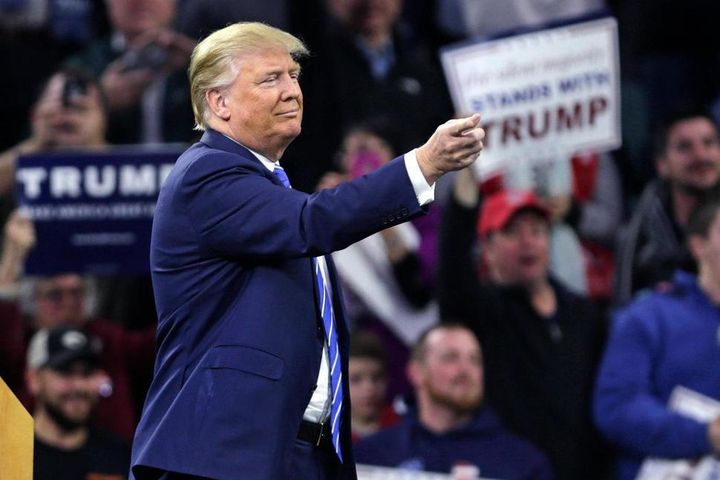
The President appears to regale in actual sadism as shown here as he encourages the removal and potential “roughing up” of a protester at a 2016 campaign rally in Lowell, Massachusetts.
Professional wrestlers commit “dastardly” acts in the ring. But no professional wrestler with whom Dr. Reiss has known would ever mimic a disabled person who was not part of a pre-scripted storyline, nor encourage actual violence outside of the ring, nor endorse wholesale, mean-spirited and sadistic lying.
Donald Trump, go back to the WWE, please – and learn what professional wrestling is really about for professional wrestlers: talent, courage, sacrifice and RESPECT.
